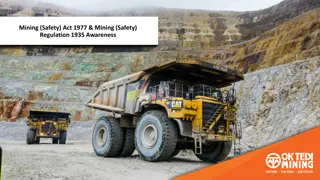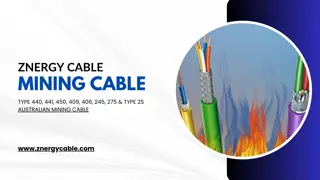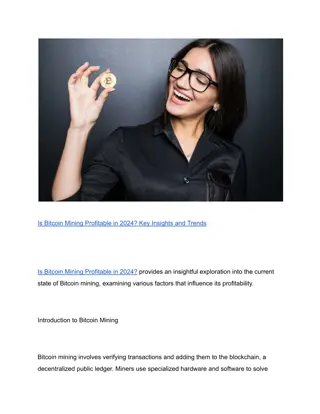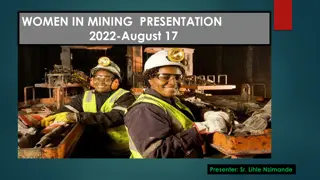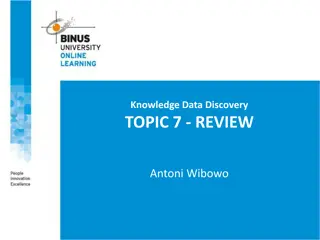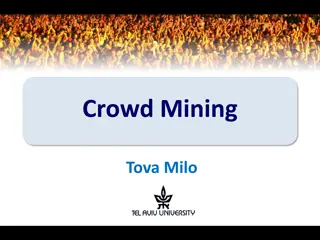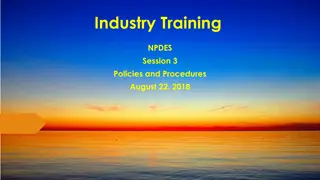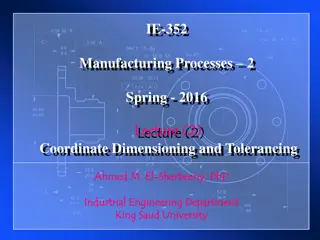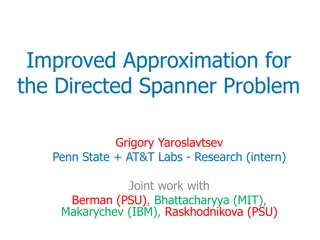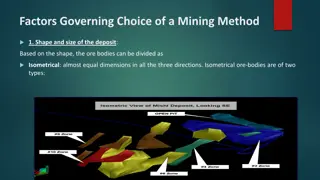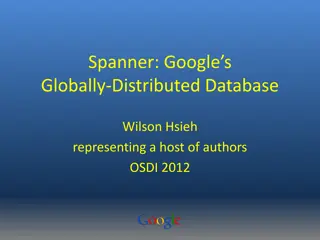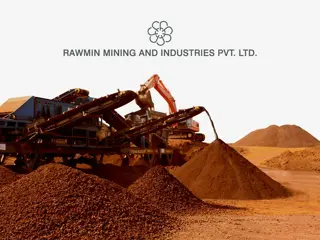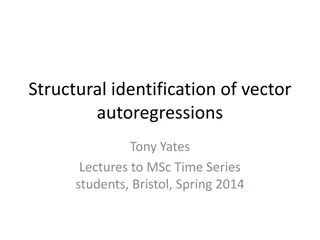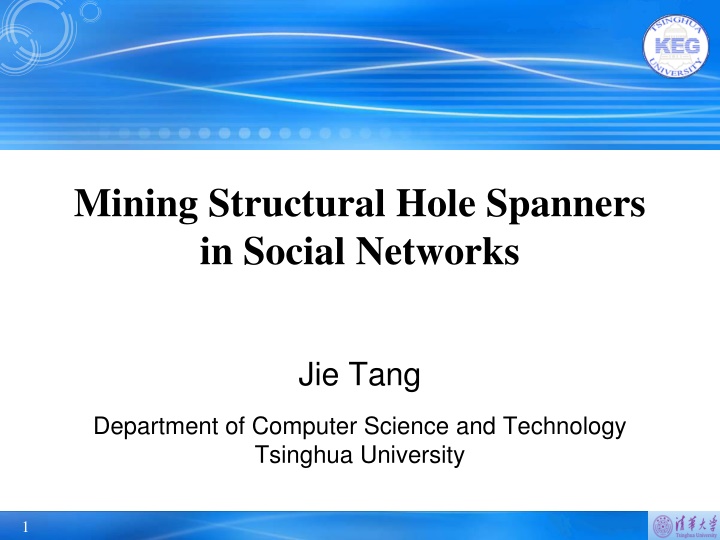
Unlocking Structural Hole Spanners in Social Networks
Explore the concept of structural holes in social networks, bridging clusters with unique information. Discover the potential of social networks, connecting physical and virtual realms, offering a trillion-dollar opportunity. Delve into core research areas on social network analysis, diffusion, and behavior. Uncover the significance of structural holes in network information flow and connectivity.
Download Presentation

Please find below an Image/Link to download the presentation.
The content on the website is provided AS IS for your information and personal use only. It may not be sold, licensed, or shared on other websites without obtaining consent from the author. If you encounter any issues during the download, it is possible that the publisher has removed the file from their server.
You are allowed to download the files provided on this website for personal or commercial use, subject to the condition that they are used lawfully. All files are the property of their respective owners.
The content on the website is provided AS IS for your information and personal use only. It may not be sold, licensed, or shared on other websites without obtaining consent from the author.
E N D
Presentation Transcript
Mining Structural Hole Spanners in Social Networks Jie Tang Department of Computer Science and Technology Tsinghua University 1
Social Networks >1000 million users The 3rdlargest Country in the world More visitors than Google >800 million users 2013, users, 40% yearly increase 560 million 2009, 2 billion tweets per quarter 2010, 4 billion tweets per quarter 2011, tweets per quarter 25 billion More than 6billion images Pinterest, with a traffic higher than Twitter and Google 2
A Trillion Dollar Opportunity Social networks already become a bridge to connect our daily physical life and the virtual web space On2Off [1] [1] Online to Offline is trillion dollar business http://techcrunch.com/2010/08/07/why-online2offline-commerce-is-a-trillion-dollar-opportunity/ 3
Core Research in Social Network Information Diffusion Application Prediction Search Advertise Macro Meso Micro Social Network Analysis Community ER model BA model Structural influence Social tie behavior Action Social Group hole Algorithmic Foundations Social Theories Theory BIG Social Data 4
Today, let us start with the notion of structural hole 5
What is Structural Hole? Structural hole: When two separate clusters possess non- redundant information, there is said to be a structural hole between them.[1] Structural hole spanner Structural hole spanner [1] R. S. Burt. Structural Holes: The Social Structure of Competition. Harvard University Press, 1992. 6
Few People Connect the World Six degree of separation[1] In that famous experiment Half the arrived letters passed through the same three people. It s not about how we are connected with each other. It s about how we are linked to the world through few gatekeepers [2]. How could the letter from a painter in Nebraska been received by a stockbroker in Boston? [1] S. Milgram. The Small World Problem. Psychology Today, 1967, Vol. 2, 60 67 [2] M. Gladwell. The Tipping Point: How Little Things Can Make A Big Difference. 2006. 7
Structural hole spanners control information diffusion The theory of Structural Hole [Burt92]: Holes exists between communities that are otherwise disconnected. Structural hole spanners Individuals would benefitfrom filling the holes . Community 2 a7 Community 1 a1 On Twitter, Top 1% twitter users control 25% retweeting flow between communities. a0 a6 a4 a8 a3 a2 a5 a11 a9 Information diffusion a10 Community 3 8
Examples of DBLP & Challenges DataMining Database 82 overlapped PC members of SIGMOD/ICDT/VLDB and SIGKDD/ICDM during years 2007 2009. Challenge 2 : Who control the information diffusion? Challenge 1 : Structural hole spanner vs Opinion leaders 9
Mining Top-k Structural Hole Spanners [1] T. Lou and J. Tang. Mining Structural Hole Spanners Through Information Diffusion in Social Networks. In 10 WWW'13. pp. 837-848.
Problem Definition Which node is the best structural hole spanner? Community 2 Community 1 Well, mining top-k structural hole spanners is more complex 11
Problem definition INPUT : A social network, G = (V, E) and L communities C = (C1, C2, , CL) Identifying top-k structural hole spanners. max Q(VSH, C), with |VSH| = k Utility function Q(V*, C) : measure V* s degree to span structural holes. VSH: Top-k structural holes spanners as a subset of k nodes 12
Data #User #Relationship #Messages 1,572,277 papers Coauthor 815,946 2,792,833 2,409,768 tweets Twitter 112,044 468,238 3,880,211 patents Inventor 2,445,351 5,841,940 In Coauthor, we try to understand how authors bridge different research fields (e.g., DM, DB, DP, NC, GV); In Twitter, we try to examine how structural hole spanners control the information diffusion process; In Inventor, we study how technologies spread across different companies via inventors who span structural holes. 13
Our first questions Observable analysis How likely would structural hole spanners connect with opinion leaders ? How likely would structural hole spanners influence the information diffusion ? 14
Structural hole spanners vs Opinion leaders Structural hole vs. Opinion leader vs. Random Result: Structural hole spanners are more likely to connect important nodes +15% - 50% The two-step information flow theory[1] suggests structural hole spanners are connected with many opinion leaders [1] E. Katz. The two-step flow of communication: an up-to-date report of an hypothesis. In Enis and Cox(eds.), 15 Marketing Classics, pages 175 193, 1973.
Structural hole spanners control the information diffusion Opinion leaders 5 times higher Structural hole spanners 3 times higher Results: Opinion leaders controls information flows within communities, while Structural hole spanners dominate information spread across communities. 16
Structural hole spanners influence the information diffusion In the Coauthor network : Structural hole spanners almost double opinion leaders on number of cross domain (and outer domain) citations. 17
Intuitions Structural hole spanners are more likely to connect important nodes in different communities. Model 1 : HIS Structural hole spanners control the information diffusion between communities. Model 2 : MaxD 18
Models, Algorithms, and Theoretical Analysis 19
Model One : HIS Structural hole spanners are more likely to connect important nodes in different communities. If a user is connected with many opinion leaders in different communities, more likely to span structural holes. If a user is connected with structural hole spanners, more likely to act as an opinion leader. 20
Model One : HIS Structural hole spanners are more likely to connect important nodes in different communities. If a user is connected with many opinion leaders in different communities, more likely to span structural holes. If a user is connected with structural hole spanners, more likely to act as an opinion leader. Model I(v, Ci) = max { I(v, Ci), i I(u, Ci) + S H(u, S)} H(v, S) = min { I(v, Ci) } I(v, Ci) : importance of v in community Ci. H(v, S) : likelihood of v spanning structural holes across S (subset of communities). and are two parameters 21
Algorithm for HIS By PageRank or HITS Parameter to control the convergence 22
Theoretical AnalysisExistence Given i and S, solution exists ( I(v, Ci), H(v, S) 1 ) for any graph, if and only if, i + S 1. For the only if direction Suppose i + S > 1, S = {Cblue, Cyellow} u v r(u) = r(v) = 1; I(u,Cblue) = I(u,Cyellow) = 1; H(u,S) = min { I(u, Cblue), I(u, Cyellow)}=1; I(v, Cyellow) i I(u, Ci) + S H(u, S) = i + S > 1 I(v, Ci) = max { I(v, Ci), i I(u, Ci) + S H(u, S) } H(v, S) = min { I(v, Ci) } 23
Theoretical AnalysisExistence Given i and S, solution exists ( I(v, Ci), H(v, S) 1 ) for any graph, if and only if, i + S 1. For the if direction If i + S 1, we use induction to prove I(v, Ci) 1; Obviously I(0)(v, Ci) r(v) 1; Suppose after the k-th iteration, we have I(k)(v, Ci) 1; Hence, in the (k + 1)-th iteration, I(k+1)(v, Ci) iI(k)(u, Ci) + SH(k)(u, S) ( i + S)I(k)(u, Ci) 1. I(v, Ci) = max { I(v, Ci), i I(u, Ci) + S H(u, S) } H(v, S) = min { I(v, Ci) } 24
Theoretical AnalysisConvergence Denote = i + S 1, we have |I(k+1)(v, Ci) - I(k)(v, Ci)| k When k = 0, we have I(1)(v, Ci) 1, thus |I(1)(v, Ci)-I(0)(v, Ci)| 1 Assumeafter k-th iteration, we have |I(k+1)(v, Ci)-I(k)(v, Ci)| k After(k+1)-th iteration, we have I(k+2)(v, Ci) = iI(k+1)(u, Ci) + SH(k+1)(u, S) i[I(k)(u, Ci)+ k] + S[H(k+1)(u, S)+ k] iI(k)(u, Ci) + SH(k+1)(u, S) + k+1 I(k+1)(u, Ci) + k+1 25
Convergence Analysis Parameter analysis. The performance is insensitive to the different parameter settings. 26
Model Two: MaxD The minimal cut D of a set communities C is the minimal number of edges to separate nodes in different communities. Removing V6 decreases the minimal cut as 2 The structural hole spanner detection problem can be cast as finding top-k nodes such that after removing these nodes, the decrease of the minimal cut will be maximized. Two communities with the minimal cut as 4 27
Model Two: MaxD Structural holes spanners play an important role in information diffusion Q(VSH, C) = MC (G, C) MC (G \ VSH, C) MC(G, C)= the minimal cut of communities C in G. 28
Hardness Analysis Q(VSH, C) = MC (G, C) MC (G \ VSH, C) Hardness analysis If |VSH|= 2, the problem can be viewed as minimal node-cut problem We already have NP-Hardness proof for minimal node-cut problem, but the graph is exponentially weighted. Proof NP-Hardness in an un-weighted (polybounded -weighted) graph, by reduction from k-DENSEST-SUBGRAPH problem. 29
Hardness Analysis Let us reduce the problem to an instance of the k-DENSEST SUBGRAPH problem Given an instance {G =<V, E>, k, d} of the k-DENSEST SUBGRAPH problem, n=|V|, m=|E|; Build a graph G with a source node S and target node T; Build n nodes connecting with S with capacity n*m; Build n nodes for each edge in G , connect each of them to T with capacity 1; 1 X1 Y1 1 n*m 1 1 Y2 T X2 ... 1 S ... 1 1 n*m Xn Yn*m 30
Hardness Analysis (cont.) Build a link from xi to yj with capacity 1 if the xi in G appears on the j-th edge; MC(G)=n*m; The instance is satisfiable, if and only if there exists a subset |VSH|=k such that MC(G\VSH) <= n(m-d) 1 X1 Y1 1 n*m 1 1 Y2 T X2 ... 1 S ... 1 1 n*m Xn Yn*m 31
Proof: NP-hardness (cont.) For the only if direction Suppose we have a sub-graph consists of k nodes {x } and at least d edges; We can choose VSH={x}; For the k-th edge y in G , if y exists in the sub-graph, two nodes appearing on y are removed in G; Thus y cannot be reached and we lost n flows for y; Hence, we have MC(G \ VSH) <= n*(m-d). 32
Proof: NP-hardness (cont.) For the if direction If there exists a k-subset VSH such that MC(G\VSH) <= n*(m-d); Denote VSH =VSH^{x}, the size of VSH is at most k, and MC(G\VSH ) <= n*(m-d); Let the node set of the sub-graph be VSH , thus there are at least d edges in that sub-graph. 33
Approximation Algorithm Two approximation algorithms: Greedy: in each iteration, select a node which will result in a max-decrease of Q(.) when removed it from the network. Network-flow: for any possible partitions ES and ET, we call a network-flow algorithm to compute the minimal cut. An example: finding top 3 structural holes Step 1: select V8 and decrease the minimal cut from 7 to 4 Step 2: select V6 and decrease the minimal cut from 4 to 2 Step 3: select V12 and decrease the minimal cut from 2 to 0 34
Approximation Algorithm Greedy : In each round, choose the node which results in the max-decrease of Q. Step 1: Consider top O(k) nodes with maximal sum of flows through them as candidates. Step 2: Compute MC(*, *) by trying all possible partitions. Complexity: O(22lT2(n)); T2(n) the complexity for computing min-cut Approximation ratio: O(log l) 35
Results 36
Experiment #User #Relationship #Messages Coauthor 815,946 2,792,833 1,572,277 papers Twitter 112,044 468,238 2,409,768 tweets Inventor 2,445,351 5,841,940 3,880,211 patents Evaluation metrics Accuracy (Overlapped PC members in the Coauthor network) Information diffusion on Coauthor and Twitter. Baselines Pathcount: #shortest path a node lies on 2-step connectivity: #pairs of disconnected neighbors Pagerank and PageRank+: high PR in more than one communities 37
Experiments Accuracy evaluation on Coauthor network Predict overlapped PC members on the Coauthor network. +20 40% on precision of AI-DM, DB-DM and DP-NC What happened to AI-DM? 38
Experiment results (accuracy) What happened to AI-DB? Only 4 overlapped PC members on AI and DB during 2007 2009, but 40 now. Our conjecture : dynamic of structural holes. Structural holes spanners of AI and DB form the new area DM. Similar pattern for 1) Collaborations between experts in AI and DB. 2) Influential of DM papers. Significantly increase of coauthor links of AI and DB around year 1994. Most overlapped PC members on AI and DB are also PC of SIGKDD 39
Maximization of Information Spread Clear improvement. (2.5 times) Improvement is limited, due to top a few authors dominate. Top 0.2% - 10 % Top 1% - 25 % Improvement is statistically significant (p << 0.01) 40
Case study on the inventor network Most structural holes have more than one jobs. Inventor HIS MaxD Title Professor (MIT Media Lab) E. Boyden Associate Professor (MIT McGovern Inst.) Group Leader (Synthetic Neurobiology) Founder and Manager (Protia, LLC) Mark * on inventors with highest PageRank scores. HIS selects people with highest PageRank scores, MaxD tends to select people how have been working on more jobs. A.A. Czarnik Visiting Professor (University of Nevada) Co-Founder (Chief Scientific Officer) Director of Operations (WBI) A. Nishio Director of Department Responsible (IDA) Senior vice President (Walt Disney) E. Nowak* Secretary of Trustees (The New York Eye) Consultant (various wireless companies) A. Rofougaran Co-founder (Innovent System Corp.) Leader (RF-CMOS) S. Yamazaki* President and majority shareholder (SEL) 41
Efficiency Running time of different algorithms in three data sets Inefficient!! 42
Applications 43
Detecting Kernel Communities Community kernel detection GOAL : obtain the importance of each node within each community (as kernel members). HOW : kernel members are more likely to connect structural hole spanners. [1] L. Wang, T. Lou, J. Tang, and J. E. Hopcroft. Detecting Community Kernels in Large Social Networks. In 44 ICDM 11. pp. 784-793.
Detecting Kernel Communities Community kernel detection GOAL : obtain the importance of each node within each community (as kernel members). HOW : kernel members are more likely to connect structural hole spanners. Clear improvements on F1-score, average of 5% 45
Model applications Link prediction GOAL : predict the types of social relationships (on Mobile and Slashdot) HOW : users are more likely to have the same type of relationship with structural hole spanners. Probabilities that two users (A and B) have the same type of relationship with user C, conditioned on whether user C spans a structural hole or not. [1] J. Tang, T. Lou, and J. Kleinberg. Inferring Social Ties across Heterogeneous Networks. In WSDM 12. pp. 46 743-752.
Model applications Link prediction GOAL : predict the types of social relationships (on Mobile and Slashdot) HOW : users are more likely to have the same type of relationship with structural hole spanners. Significantly improvement of 1% to 6% [1] J. Tang, T. Lou, and J. Kleinberg. Inferring Social Ties across Heterogeneous Networks. In WSDM 12. pp. 47 743-752.
Conclusion 48
Conclusion Study an interesting problem : structural hole spanner detection. Propose two models (HIS and MaxD) to detect structural hole spanner in large social networks, and provide theoretical analysis. Results 1% twitter users control 25% retweeting behaviors between communities. Application to Community kernel detection and Link prediction 49
Future works Combine the topic leveled information with the user network information. Dynamics of structural holes Data Mining Database Artificial Intelligence What s the difference between the patterns of structural hole spanners on other networks? 50

![[PDF⚡READ❤ONLINE] Black Hole Astrophysics: The Engine Paradigm (Springer Praxis](/thumb/21503/pdf-read-online-black-hole-astrophysics-the-engine-paradigm-springer-praxis.jpg)
